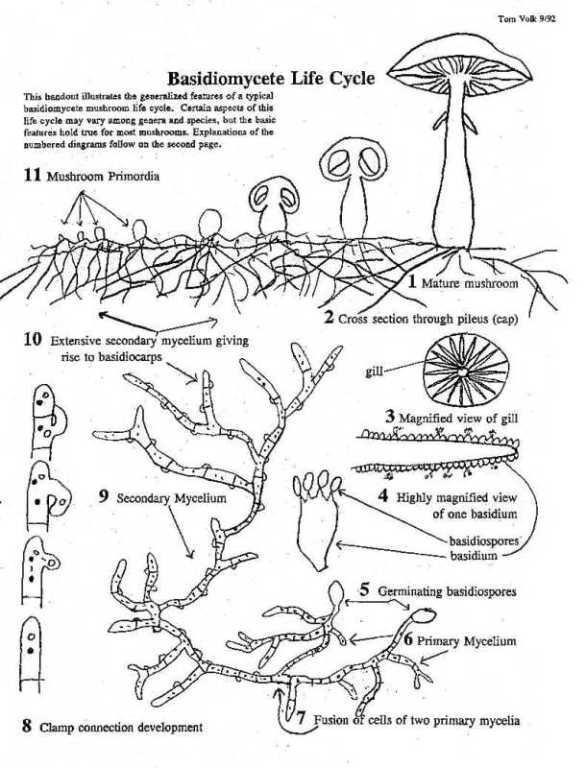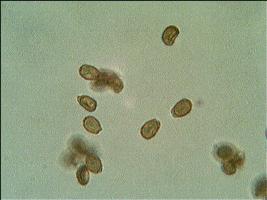Reproduction
HOW DOES GANODERMA APPLANATUM REPRODUCE?
Basidiomycetes have a complex reproductive cycle. Two haploid mycelia, one male and one female, undergo plasmogamy. Plasmogamy is the fusion of the cytoplasm of cells from two individuals. After plasmogamy occurs, a dikaryotic mycelium is formed. This dikaryotic mycelium grows fast and will basically kick the haploid parental mycelia out. When certain changes in the environment occur, the dikaryotic mycelium grows into a basidiocarp, or a bracket in the Ganoderma applanatum species. This fungus has pores on the underside of the bracket. In these pores, there are dikaryotic cells called basidia. When they undergo karyogamy, they form a diploid nucleus within the basidia. Karyogamy is the fusion of two nuclei. When the diploid nuclei go through meiosis, there are four haploid nuclei formed. Each haploid nucleus will form into a basidiospore. When maturity is reached the spores are released and dispersed via wind dissemination. In a suitable environment, basidiospores germinate and grow into short-lived haploid mycelia, and the cycle starts again. This is JUST a general life cycle of basidiomycete reproduction. There could be a few minor details that are different in different species. Therefore, I decided it would be a good idea to show you a general life cycle. This was created by Dr. Tom Volk. If you are interested in mycology, check out his website to see his work. It is full of great information on different fungal species.
The
spores of Ganoderma applanatum are unique and have distinct characteristics.
But first, I need to tell you about where the spores come from; basidia,
which are spore-producing cells, line the walls of the pores. These pores
are located on the underside of the fruiting body. In order for the spores
to drop down and out of the fruiting body, it is crucial that the spores do
not stick to the sides of the pores; they must drop down the vertical pore
directly into the air. Alrighty, now back to the spores. Ganoderma
applanatum have very distinct spores. The spores are broadly elliptical and
blunt at the distal end, like shown in the picture to the left. They can be anywhere
from 7.6 to 11.5 micrometers. They also have thick
walls and minute spines. When deposited they are brown in color. They
collect on the TOP of cap!
PERSONAL EXPERIENCE
I found a cluster of five fruiting bodies on a dying tree while walking through Myrick Marsh. I looked up and saw a large bracket covering a much smaller bracket. I thought that, maybe, since it was smaller in size, that it would be easier to tear the bracket from the tree. In the video below, you can see the difficulty I was having. Regardless of size, this fungus is very DIFFICULT to remove from any surface.
It is difficult to break with your hands because of the thick-walled hyphae and interwoven path it makes. Another reason for being so tough is the fact that the bracket adds a new layer of spore tissue each season of growth; this closely resembles the growth rings of a tree. Below left, there is a picture of a bracket with one tube layer. So I tried to break the bracket the first time. I brought my hand away, looked at my hand, and just about through a fit!
This cluster was found in the end of March. Many other fruiting bodies of Ganoderma applanatum that I encountered that day did not have ANY brown spores, so I was pretty excited about my find. I tried again to remove the bracket from the tree, and this time I was successful. The picture above, on the right, is what I found. The small fruiting body was LOADED with spores; I was able to look at them more closely and see how many spores actually reside there. I was really pumped, to say the least, and this find kept me hopeful while searching for more Ganoderma applanatum.
NEXT PAGE = INTERACTIONS
 Artist's Conk (Ganoderma applanatum)
Artist's Conk (Ganoderma applanatum)
